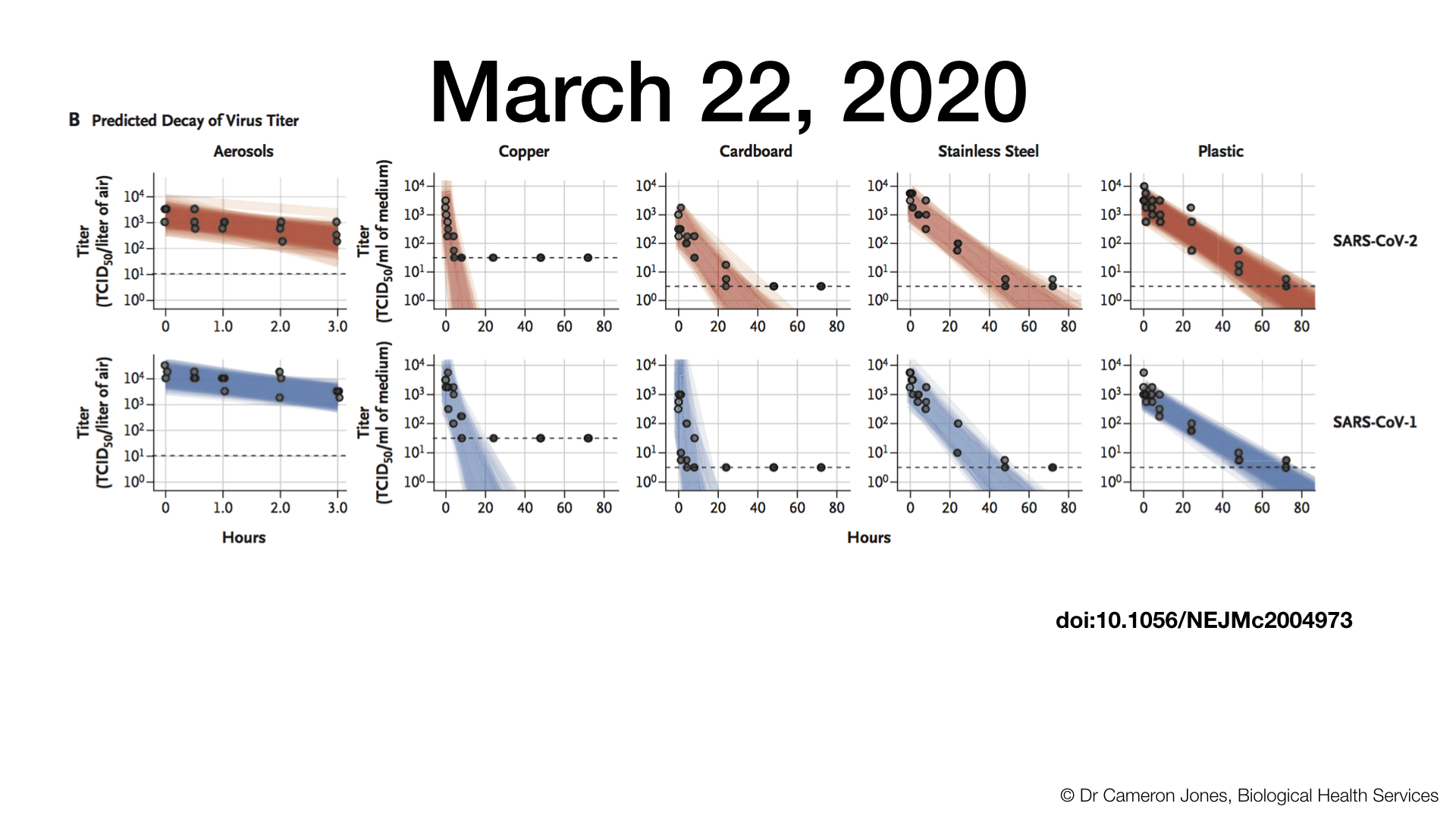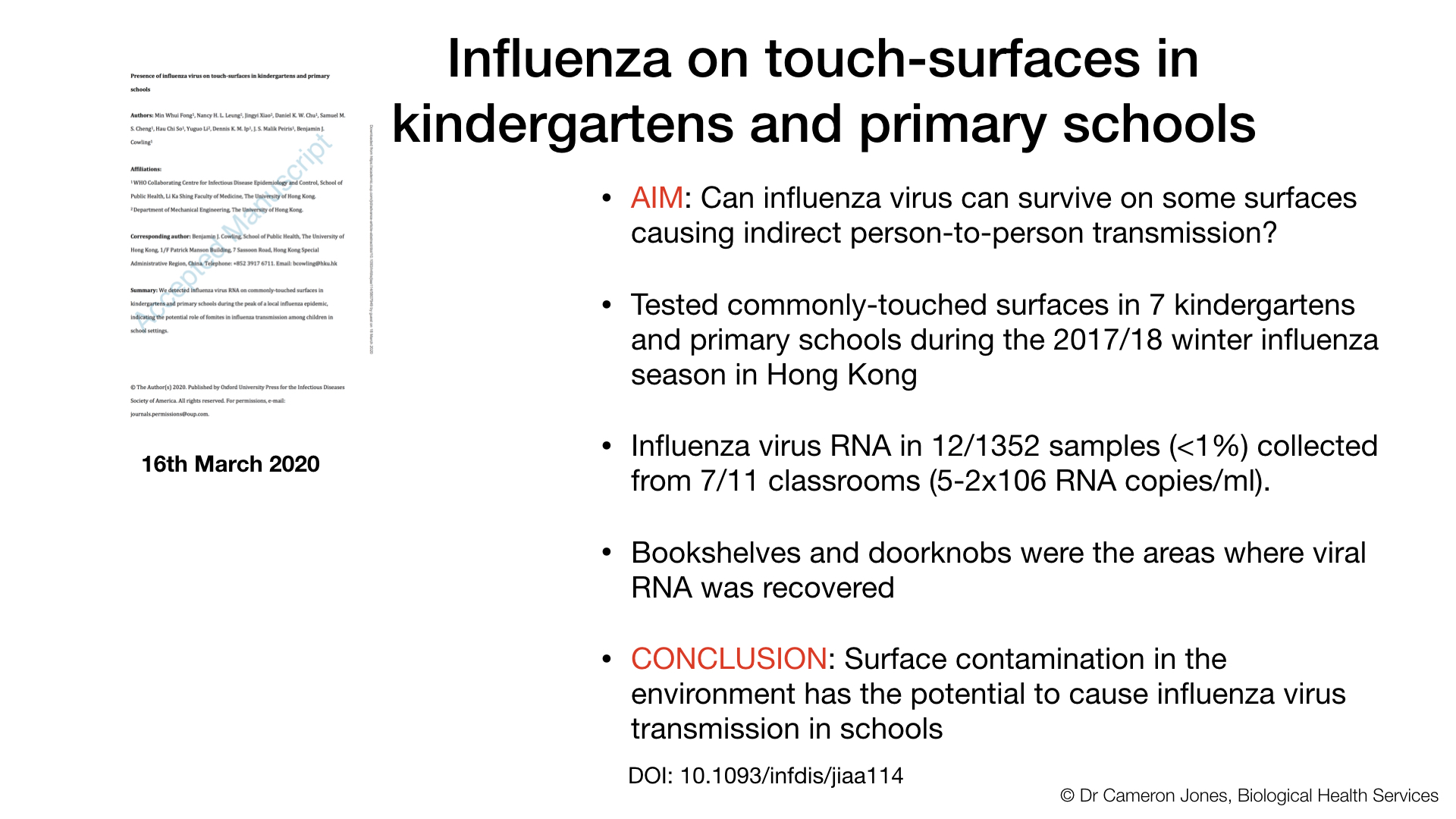How Long Can SARS-CoV-2 Survive on Surfaces?
What's safe to touch to minimize your risk of coming in contact with coronavirus?
If I touch that surface or object could I get sick from the virus, SARS-CoV-2 that causes the disease, COVID-19? That's the aim of this podcast to review what we know about airborne and surface transmission. SARS-CoV-2 is a virus, so it's technically not alive...but if the viral RNA ends up on a doorknob or on an extractor fan, then you could unknowingly come into contact with it. This is called fomite transmission. Today's episode reviews what we know about the survival of the virus on inanimate objects. We find that it survives less well on copper surfaces and longer on plastic than on cardboard. It can also be cleaned from the hospital rooms of patients diagnosed with the virus. But, if the room is not cleaned, then the virus can remain on many typical touch surfaces. There is even a link with fecal shedding and the toilet.
Cruise ships and virus stability on surfaces
Next, I review the data from The Diamond Princess where it was found that the virus could be recovered from. Cabins after 17 days. That's a long time to remain infectious. What can you do? Well, there's a US EPA site that lists all the disinfectants that should work for SARS-CoV-2 against COVID-19 and I review some of the typical ones and their efficacy.
The slide below shows you a summary of what we know about how long the coronavirus can remain stable in the air and on surfaces. This paper covered the aerosol and surface stability of the SARS-CoV-2 virus on typical surfaces like cardboard, stainless steel, and plastic.

But how long really does the virus remain viable and able to cause infection?
Now let's look at some typical decay curves for the time (in hours) on several different types of materials including copper, cardboard, stainless steel and on plastic. The top panel shows the most recent coronavirus (in RED), while the bottom graphs show the earlier SARS-CoV-1 (in BLUE).

When you're reading the x-axis, bear in mind that the tick marks show Hours (hrs). Therefore you can follow along with the decay in viability to the end of the experiment, which was at the 80 hr point - which is over 3 days! That's a long time to maintain viability, don't you think?
Environmental contamination with coronavirus is a serious and hidden transmission pathway
Cruise ships have long been known to be ideal places for outbreaks of infectious diseases. This is mainly due to the large numbers of people who are in close proximity to each other, the opportunity for consumption of contaminated food or water and the fact that the median age of cruise passengers is over 45 years old. This means that many persons could also suffer from other medical conditions that could exacerbate the potential for infections.

What surface disinfectants should inactivate SARS-CoV-2?
Of course, I keep being asked what is the best way to clean suspect surfaces. I am referring people to the USA EPA List N. I'm sure some Australian expert sites will emerge on this topic, but this site allows you to look up the active ingredient and see if it's likely to work.

I've also just discovered a new paper that appeared in the Global Biosecurity journal that provides a mini-review of the disinfection measures that work for SARS-CoV-2. Its a great paper and free to read.
News of the week
The Breaking News section of this podcast discusses how nanofibrils of cellulose have been used to change the way building composite boards are produced. This is a great example of materials science and the search for replacements for formaldehyde. Who knows, these new 'green' manufacturing methods may also confer other benefits like antibacterial/anti-fungal properties due to the inclusion of boric acid.
The last paper, I want to highlight comes out of Hong Kong and looks at seasonal influenza and how RNA could be recovered from the tops of bookshelves and door handles. The levels were low, but the authors postulate that fomite transmission might exacerbate childhood influenza illness and propagation. This is an important topic since childcare centres have been identified as coronavirus hotspots and have appeared in the news in the past weeks. It's also been claimed that potentially up to 80% of children are infected but are asymptomatic according to one report from New York City.

LINK TO FACEBOOK LIVESTREAM:
Every week, I do live streams on public health topics. Join me on Facebook.
Dr. Cameron Jones
REFERENCES:
Kampf G, Todt D, Pfaender S, Steinmann E. Persistence of coronaviruses on inanimate surfaces and their inactivation with biocidal agents. Journal of Hospital Infection. 2020;104(3):246-251. doi:10.1016/j.jhin.2020.01.022
Thomas Y, Vogel G, Wunderli W, et al. Survival of influenza virus on banknotes. Appl Environ Microbiol. 2008;74(10):3002–3007. doi:10.1128/AEM.00076-08. https://aem.asm.org/content/74/10/3002
Angelakis E, Azhar EI, Bibi F, et al. Paper money and coins as potential vectors of transmissible disease. Future Microbiol. 2014;9(2):249–261. doi:10.2217/fmb.13.161. https://doi.org/10.2217/fmb.13.161
Ong S, Tan Y, Chia P et al. Air, Surface Environmental, and Personal Protective Equipment Contamination by Severe Acute Respiratory Syndrome Coronavirus 2 (SARS-CoV-2) From a Symptomatic Patient. JAMA. 2020. doi:10.1001/jama.2020.3227
van Doremalen N, Bushmaker T, Morris DH, et al. Aerosol and Surface Stability of SARS-CoV-2 as Compared with SARS-CoV-1 [published online ahead of print, 2020 Mar 17]. N Engl J Med. 2020;10.1056/NEJMc2004973. doi:10.1056/NEJMc2004973 ; https://www.nejm.org/doi/full/10.1056/NEJMc2004973
Demirci M, Celepler Y, Dincer S, et al. Should we leave the paper currency? A microbiological examination. Rev Esp Quimioter. 2020;33(2):94–102. doi:10.37201/req/085.2019
Ejaz H, Javeed A, Zubair M. Bacterial contamination of Pakistani currency notes from hospital and community sources. Pak J Med Sci. 2018;34(5):1225–1230. doi:10.12669/pjms.345.15477
Zarayneh S, Sepahi AA, Jonoobi M, Rasouli H. Comparative antibacterial effects of cellulose nanofiber, chitosan nanofiber, chitosan/cellulose combination and chitosan alone against bacterial contamination of Iranian banknotes. Int J Biol Macromol. 2018;118(Pt A):1045–1054. doi:10.1016/j.ijbiomac.2018.06.160
List N: Disinfectants for Use Against SARS-CoV-2 | US EPA. US EPA. https://www.epa.gov/pesticide-registration/list-n-disinfectants-use-against-sars-cov-2. Published 2020. Accessed March 25, 2020.
Fong MW, Leung NHL, Xiao J, et al. Presence of influenza virus on touch-surfaces in kindergartens and primary schools [published online ahead of print, 2020 Mar 16]. J Infect Dis. 2020;jiaa114. doi:10.1093/infdis/jiaa114
Xu, X., Liu, F., Jiang, L., Zhu, J.J., Haagenson, D., & Wiesenborn, D.P. (2013). Cellulose nanocrystals vs. cellulose nanofibrils: a comparative study on their microstructures and effects as polymer reinforcing agents. ACS applied materials & interfaces, 5 8, 2999-3009 .
Aussie newsagent bans cash over coronavirus fears | A Current Affair. https://youtu.be/qSjKM2qOYNk
Moriarty LF, Plucinski MM, Marston BJ, et al. Public Health Responses to COVID-19 Outbreaks on Cruise Ships — Worldwide, February–March 2020. MMWR Morb Mortal Wkly Rep. ePub: 23 March 2020. DOI: http://dx.doi.org/10.15585/mmwr.mm6912e3
NEWS:
Hafez I, Tajvidi M. Laminated Wallboard Panels Made with Cellulose Nanofibrils as a Binder: Production and Properties. Materials (Basel). 2020;13(6):E1303. Published 2020 Mar 13. doi:10.3390/ma13061303


